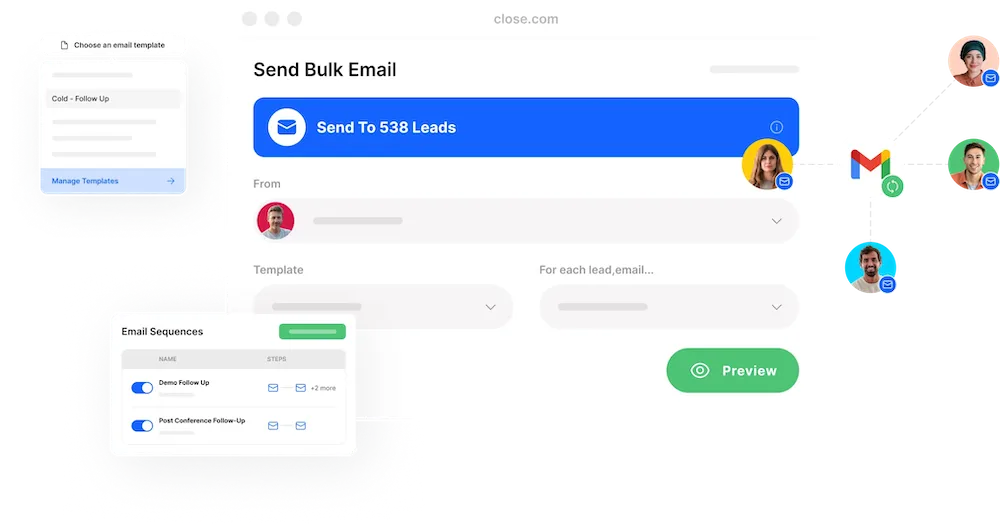
The best salespeople get prospects to buy now, not later.
Why is this so important? Because if you're not careful, "later" will become "never," and all that time you spent nurturing your prospect will be wasted. I've seen it happen a million times.
The truth is most people look for reasons not to buy things. You could offer them the fountain of youth, and they'd say, "No thanks. There's no room in my backyard for a water feature."
Fortunately, there are plenty of ways to create urgency in sales, all but ensuring your prospects pull the trigger and actually purchase your products or services. Before I share seven of the most popular ones with you, let’s discuss the benefits and challenges of creating sales urgency.
The Benefits + Challenges of Sales Urgency
Before we discuss ways to add a sense of urgency to your sales process, let's talk about why you should.
According to Gaurav Nagani, the CEO of Desku Inc, this is because, "People are more likely to buy when they feel like they're missing out on something or that they need to act now." Create that feeling in them, and your sales number will rise.
But sales professionals need to be careful. An overly urgent approach may actually dissuade potential customers from purchasing. They'll think, "Why won't this person leave me alone? I'll decide to buy when I'm ready. Guess when that will be. That's right, NEVER."
One more thing: if every sales message you send is urgent, you'll develop a bad reputation in the marketplace. Why? Because you'll lose the respect and trust of your target audience. People want to buy from respectful professionals, not slimy snake oil sales reps.
Fortunately, the sales tips I share below will help you strike a balance between buy-right-now sales techniques and the honest, genuine persona you want to project. Here are some ways to do that.
7 Ways to Create Urgency in Sales (That Won’t Ruin Your Reputation!)
Purchase any kind of sales training program on the internet, and it will tell you that sales urgency is important. It might not tell you how to create urgency, though. Don't worry, I got you. Keep reading for seven sales tips you can use to entice prospects to buy now.
1. Know Your Customer’s Pain Points
The first rule of sales: know your customers.
You'll never close deals if you don't know who you're selling to. How could you? You won't know what makes your target audience tick. As such, you won't know which value propositions will influence your prospects' decision-making processes in positive ways.
How does this relate to sales urgency? When you know your customers and their specific pain points, you can present your company's products/services as a viable solution. This suggestion will naturally create urgency because prospects want to solve their problems ASAP.
Krittin Kalra, the Founder of Writecream, said it best when he said, "By learning your customer’s pain points, then highlighting the benefits of your solution, you are able to show the customer how your product can make a positive impact on their business."
Jumping right into sales conversations is a beginner's mistake. Learn about your ideal customers first. Doing so will allow you to add urgency to your sales presentations easily.
 |
2. Create a Feeling of Scarcity
"Scarcity" and "Urgency" are two trippin' peas in a far-out pod.
Create the first, and you'll almost certainly create the second—especially if your target market highly desires the product and/or service you've made scarce.
There are multiple ways to create scarcity, but limiting the availability of an offer or product is the easiest.
Ryan Mckenzie, the Co-Founder and CMO of Tru Earth, has this sales technique down. He says, "Introduce limited-time discounts, exclusive deals, or set deadlines for customers to take advantage of additional perks or bonuses. This tactic often works well as it instills a fear of missing out (FOMO) in customers, prompting them to act quickly."
If you plan to release a new product in the near future, you can capitalize on scarcity by running a "Limited Alpha" campaign as well, which limits the number of people who get to try your new product.
You can say, "This looks like a great fit, but I want you to know that we are going to run a limited alpha, which means that only ten companies will get access to our product. We currently have 40 companies interested in participating."
Your customers will be trampling each other to purchase your new offering.
3. Mention an Upcoming Price Increase
We can all agree that paying more money for things sucks. Use this to your advantage as a salesperson.
Daniel Chabert, the CEO and Founder of PurpleFire, says, "If your product or service prices are expected to rise in the near future, inform your clients. Knowing that they can lock in a lower price today will encourage them to act quickly, before the increase takes effect."
This sales tip is pretty easy to implement. Simply hop on a sales call, or send a quick email blast to your company's subscribers and tell them the exact date your prices will rise. Then sit back and watch as the sales start to roll in.
Of course, you can only use this strategy if you actually plan to raise prices. And you should only raise prices if it makes sense for your company. If not, file this tip away for later.
4. Make Customers an Offer They Can't Refuse
Here's an idea: offer your target market something so good they'll have to say yes. The easiest way is to give your prospect a special, limited-time deal.
Diana Stepanova, the Operations Director at Monitask, agrees, saying, "This strategy compels them to act quickly to take advantage of the deal, shortening the sales cycle."
Here are a few ways you can use this urgency-inducing technique to reach your sales goals:
- Offer a discount: You can say something like, "If you buy this week, you'll get a 25 percent discount, which will save you $XXX every year, from now until you cancel."
- Add extra features: Instead of offering a discount, include extra features in whatever package your customers purchase. "If you buy this month, we'll automatically upgrade you to the 'Pro' plan, which will give you access to XYZ features, free of charge."
- Give products/services away: If you really want to impress your customers, give them stuff for free. "Buy X product this week and get two free!"
As you can probably tell, this sales tip is similar to the scarcity tip mentioned above. But it's even more powerful because you're offering something irresistible to your ideal customers.
Just don't make these kinds of offers all the time. Doing so will probably hurt your company's bottom line. Your customers will also come to expect crazy deals, killing urgency.
5. Use Countdown Timers Strategically
Countdown timers in sales are nothing new. I'm willing to bet money that you've seen one before—probably in an email or landing page. Chances are, it enticed you to purchase.
Don't feel bad. It's happened to all of us. Something about a time limit lights a fire in our souls. The only way to put it out is to buy, buy, buy! Even if we don't really want what's being sold.
Brian Lee, the Founder and CEO of Arena Club, knows exactly why this happens. "The timer reinforces a sense of urgency to make a decision, as it gradually ticks towards zero—to buy, or not to buy. With a finite amount of time to purchase, many consumers will feel compelled to do so in fear of missing out on a good deal."
Makes sense, right? Well, guess what—you can boost sales performance with a similar tactic.
Make your target audience a strong offer. Then slap a countdown timer on your email to announce said offer to the world. Put one on your website and/or landing page, too.
 |
6. Help Prospects Realize the Cost of Procrastination
Imagine this: You've been engaging with a particular prospect for a while. You've repeatedly talked to them on the phone and sent them a dozen follow-up messages. They've spent hours on your company's website, learning everything they can about your specific offerings.
The sales process is progressing as it should and you can sense a done deal in the near future. Just make sure that your prospect never loses focus on their problem.
Oftentimes, sales reps get so excited about a potential sale that they forget why their prospects need their products. They get wrapped up in features and case studies—neither of which are at the core of the prospect's buying decision. Don't let this happen to you!
Instead, make sure your prospects are always vividly aware of their unsolved problem, the good that will come from solving it, and why your products are the best solution.
You can do this by asking them the right questions throughout the sales funnel:
- What's the most frustrating aspect of this problem?
- When would be the best time to solve this problem?
- What's the hidden cost of not solving this problem right now?
- How does this problem affect [insert metric your prospect cares about].
- How many people in your organization are affected by this problem?
- How would solving this problem affect you personally?
- How can you demonstrate to your boss that this problem is worth solving?
- If this problem was solved, what metric would best measure your new success?
(Note: this list of additional B2B sales questions will help you consistently close more deals.)
Another way to prioritize your prospect's problem is to stress statistics and data, which is one of Max Wesman’s, the COO of GoodHire, favorite approaches. He says:
"The best way to create urgency in your sales pitch is to show just how effective your solution is and how it will solve a problem that the company or client is facing. You can do this with data. By seeing the numbers and statistics and identifying just how effective it will be, the client is encouraged to take up your offer sooner rather than later."
Psst! Want to elevate your B2B approach? Master the B2B Sales Funnel strategies here.
7. Use Social Proof to Your Advantage
Finally, add an element of social proof to your sales presentations. Need convincing? A 2023 study reports that 89 percent of B2B software buyers read user reviews when buying business software products either “often” or “always.”
 |
Source: B2B SaaS Review
Meeting a prospect in person? Show them the testimonials on your company's website. Talking to a prospect on the phone? Read them a direct quote from one of your happy customers. Hosting a webinar? Interview a superfan about why they love your products.
Daniel Chabert, the CEO and Founder of PurpleFire, says that doing so can "Instill a sense of urgency in prospects, as they will not want to fall behind their industry peers."
The good news is social proof can come from anywhere: a ringing endorsement on Google, a recorded interview on your website, or a positive post about your company on a social media site like LinkedIn.
Use Urgency to Close More Deals
It doesn't matter what company you sell for. Cutting-edge e-commerce brands, old school B2B organizations, and every company in between can benefit from urgency in sales.
Once you add it to your sales strategy, you'll close more deals—I guarantee it!
Just make sure you add it the right way. Too much urgency, delivered inauthentically, will turn potential customers off and earn you a bad reputation in the marketplace. No bueno.
Fortunately, the seven sales tips above will help you create a sense of urgency that will help you make sales now and in the future after you've secured new customers for life.
You know what else can help you make sales? An efficient CRM like Close, which you can try free for the next 14 days. Sign up, then dive into our platform's industry-leading feature set that includes power and predictive dialers, automated emails, and more.
And if you want to check out the most reliable B2B CRM solutions on the market, check out our article.










